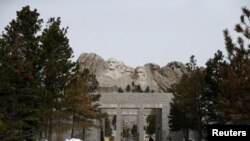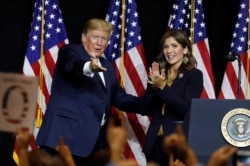President Donald Trump Friday heads to Mount Rushmore, where he will headline U.S. Independence Day celebrations featuring fireworks for the first time in more than a decade at the national park in South Dakota.
“It's going to be a fireworks display like few people have seen. It's going to be very exciting,” Trump said during a White House event Thursday.
Mount Rushmore National Memorial is a giant sculpture featuring the faces of four American presidents – George Washington, Thomas Jefferson, Theodore Roosevelt and Abraham Lincoln, carved into a granite mountainside.
This would be the first fireworks display at Mount Rushmore since 2010 when the National Park Service stopped staging pyrotechnics out of concern that they could spark wildfires. The memorial is surrounded by 486 hectares of forested land and located next to the Black Hills National Forest’s Black Elk Wilderness.
In April, the Park Service prepared an environmental assessment and concluded the fireworks would have "no significant impact."
Monumental feud
Trump’s visit comes during a national debate over monuments honoring American leaders who were slaveholders or held racist views. Universities and local governments across the country are removing controversial monuments, at a time when many Americans are protesting for ways to address systemic racism following the death of George Floyd, an African American, in police custody in May.
The president has consistently opposed protesters who want to remove statues of Confederate leaders and figures who supported slavery and white supremacy. Trump signed an executive order in June directing federal law enforcement agencies to prosecute people who damage federal monuments.
Choosing Mount Rushmore as the backdrop of this year’s Independence Day event is a political strategy clearly informed by the debate over monuments, said Vanessa Beasley, who teaches presidential rhetoric at Vanderbilt University.
“Trump is basically trying to say to his base audience; hey, if you don't like what's happening with all these monuments, I'm going to go to the biggest and most immovable monument there is and I'm going to claim it as my own,” said Beasley to VOA. “I don't think there's any nuance or ambiguity in that message.”
Americans urged to stay home
As the nation witnessed a spike in new coronavirus cases, with an 80 percent increase in the past two weeks, health officials urged Americans to stay home on July 4 – a holiday usually celebrated with big parties and town parades.
“The safest choice this holiday is to celebrate at home,” the Oregon Health Authority said in a press release.
South Dakota Governor Kristi Noem, a Republican who worked with the administration to organize the celebration at Mount Rushmore, said Monday that masks will be provided but social distancing will not be enforced.
"In South Dakota, we've told people to focus on personal responsibility. Every one of them has the opportunity to make a decision that they are comfortable with. So, we will be having celebrations of American independence; we will have a large event July 3," she said during an appearance on Fox News earlier this week.
Tickets for the 7,500-person capacity event were allocated by lottery in June.
In trying to balance personal liberties and freedom against public safety, the president and Governor Noem have decided that they want to come down on the side of personal freedom, said Michael Cornfield, associate professor of political management at The George Washington University, told VOA. “It's quite risky.”
Presidential preference
American presidents typically have celebrated July 4 based on their personal preferences and many have done so in ways that are “very much connected to what's happening at that moment”, said Matthew Costello, a historian with the White House Historical Association, in an interview with VOA.
James K. Polk, the nation’s 11th president and the one who pursued the expansion of the continental United States through wars in the mid-19th century, celebrated with military parades and other ways that were very much about patriotism, said Costello. “It was about the war effort, but it was also about continuing the fight for what he believed was in the best interest of the country.”
Trump is not the first American president to commemorate Independence Day in a pandemic. During the Spanish Flu in 1918, Woodrow Wilson reviewed a parade that marched on Pennsylvania Avenue in Washington, said Costello.
Wilson missed the 4th of July in 1919, as he was returning from the Paris Peace Conference. Many historians, including John M. Barry, professor at the Tulane University School of Public Health and author of The Great Influenza: The Story of the Deadliest Pandemic in History, believe Wilson himself fell ill with the flu around that time.










